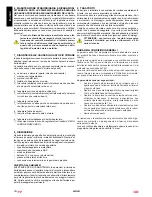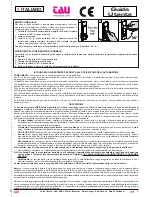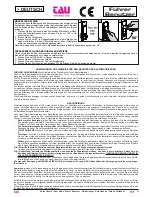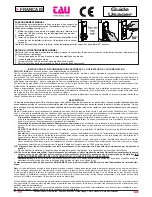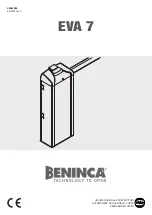
2
Guida Utente - User Guide - Führer Benutzer - Guide Usager - Guía Usuario - Guia do Utilizador
INSTRUCTIONS AND WARNINGS FOR AUTOMATIC SYSTEM USERS
CONGRATULATIONS
on choosing a Tau product for your automation system!
Tau S.r.l. produces components for automatic gates, doors, barriers and shutters. These include gear motors, control units, radio control de-
vices, flashing lights, photocells and accessories.
Tau products are exclusively made with top quality materials and processes and, as a company, we constantly research and develop innova-
tive solutions in order to make our equipment increasingly easier to use. We also pay great attention to all details (technology, appearance and
ergonomics). The extensive Tau range makes it possible for your fitter to choose the product which best meets your requirements.
Tau, however, does not produce your automated system as this is the outcome of a process of analysis, evaluation, choice of materials and
installation performed by your fitter.
Each automated system is unique, therefore, and only your fitter has the experience and professionalism required to create a system that is
tailor-made to your requirements, featuring long-term safety and reliability, and, above all, professionally installed and compliant with current
regulations.
An automated system is handy to have as well as being a valid security system. Just a few, simple operations are required to ensure it lasts for
years.
DESCRIPTION
The LUXE automatic barrier has been designed for use in private or public car parks, residential areas or areas of intense traffic.
The non-reversing system ensures the leaf is mechanically locked when the motor is not operating. A convenient and safe release system with
customised key makes it possible to manually move the bar in the event of a malfunction or of a power failure.
Even if your automated system satisfies regulatory safety standards, this does not eliminate “residue risks”, that is, the possibility of dangerous
situations being generated, usually due to irresponsible and/or incorrect use. For this reason we would like to give you some suggestions on
how to avoid these risks:
-
Before using the system for the first time:
ask your fitter to explain how residue risks can arise and read the instructions and warnings in
the user handbook that your fitter will have given you. Keep this manual for future use and, if you should ever sell your automated system,
hand it over to the new owner.
-
Your automated system carries out your commands to the letter:
irresponsible and/or incorrect use may cause it to become danger-
ous. Do not use the system if people, animals and/or objects enter its operating area.
-
IT IS NOT A TOY!
Make sure children do not play near the system and keep the remote control device out of their reach.
-
Faults:
If you notice any abnormal behaviour, disconnect the system from the power supply immediately and perform the manual release
operation (see figure). Do not attempt to repair the door but call in your fitter: the system will operate manually as it did before installation.
-
Maintenance:
to ensure long life and totally safe operation, the system required routine maintenance, just like any other piece of machin-
ery. Establish maintenance times together with your fitter. Tau recommends a frequency of 6 months for normal domestic installations but
this may vary depending on the intensity of use (always every 3000 work cycles).
N.B.: All controls, maintenance work and/or repairs may only be carried out by qualified personnel.
- Do not modify the plant or the relative programming and adjustment parameters: your fitter will see to that.
N.B. Final testing, routine maintenance and any repairs must be documented by the fitter (in the relative spaces) and such documents
kept by the owner of the system
(IF THE DOCUMENTS ARE NOT PRODUCED, THE WARRANTY WILL EXPIRE).
-
Disposal:
At the end of system life, make sure that it is demolished by qualified personnel and that the materials are recycled or disposed
of according to local regulations.
The manual manoeuvre must ONLY be done with the door stopped and AFTER disconnecting power from the electrical control unit.
N.B.:
if your remote control unit (if supplied) starts working badly after a time, or does not work at all, the batteries may be flat (they can last
from several months to 2/3 years depending on what type is used). This can be seen from the fact that the transmission confirmation LED gets
dimmer or only turns on for brief moments. Before contacting your fitter, try exchanging the battery with one from a good transmitter: if this is the
reason for the fault, simply replace the battery with another one of the same type.
If you wish to add a new automated system to your house, contact your fitter and we at Tau to have the advice of a specialist, the most developed
products on the market, best operation and maximum automation compatibility.
Thank you for reading these suggestions and we trust you are fully satisfied with your new system: please contact your fitter for any further
requirements.
>
ENGLISH
User
Guide
MANUAL OPERATION
If the bar has to be operated manually due to a power cut or malfunction
of the automated system, use the release device as follows:
1_ Insert the key into the handle lock on the back of the cabinet and
rotate by 180° in an anticlockwise direction
;
2_ take the handle out
;
3_
rotate it by 90° in an anticlockwise direction to release the bar (if it
seems to resist, apply more strength onto the handle since this will
cause no breakage)
.
When released, the bar must automatically go to the balance position (ca. 45°)
.
RESTORING NORMAL OPERATION
To prevent an involuntary pulse from activating the bar during the manoeuvre, cut power to the system before relocking the operator.
1_ Rotate the handle by 90° anticlockwise.
2_ Insert the handle in its housing.
3_ Rotate the key by 180° in a clockwise direction.
4_ Take the key out and move the bar till the releasing device engages.




